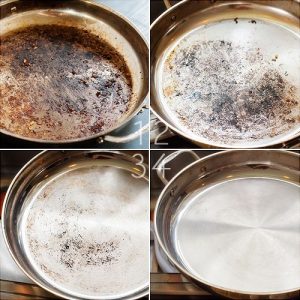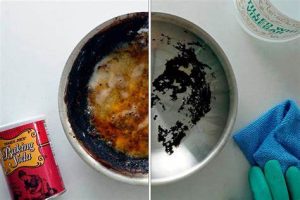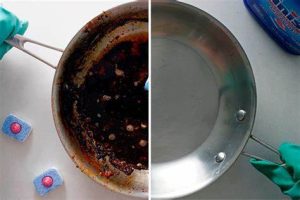Sheet pans are the unsung heroes of the kitchen, perfect for baking, roasting, and even broiling. But with repeated use, they can become covered in stubborn grease and baked-on residues that seem almost impossible to remove. In this article, we’ll explore the art of degreasing sheet pans, providing you with valuable tips and tricks to effectively tackle grease and grime, ensuring your sheet pans stay in great condition.
Why Degreasing Matters
Degreasing your sheet pans is essential for several reasons:
- Hygiene: Grease buildup can harbor harmful bacteria, making it crucial to keep your sheet pans clean to prevent foodborne illnesses.
- Enhanced Cooking: Clean sheet pans ensure even cooking and prevent sticking, allowing your dishes to turn out perfectly.
- Prolonged Lifespan: Regular cleaning and degreasing can extend the life of your sheet pans, saving you money in the long run.
https://i.pinimg.com/originals/88/3e/f6/883ef679d768686aca9f2d5376bc4f04.jpg
Degreasing Tools and Materials
Before we delve into the degreasing process, it’s important to gather the necessary tools and materials:
- Hot Water: You’ll need hot water to create a degreasing solution.
- Dish Soap: A gentle dish soap is the primary cleaning agent for degreasing.
- Baking Soda: Baking soda acts as an abrasive cleaner to tackle stubborn grease and residue.
- Vinegar: Vinegar helps break down grease and neutralizes odors.
- Aluminum Foil: Aluminum foil can be used as a scrubber to remove tough, stuck-on residues.
- A Sponge or Scrub Brush: You’ll need a sponge or scrub brush for scrubbing the sheet pans.
- Gloves: Wearing gloves is advisable to protect your hands from hot water and cleaning agents.
https://th.bing.com/th/id/OIP.lxKNCF-68OjnmvB7wY5CSwHaE8?pid=ImgDet&w=474&h=316&rs=1
Step-by-Step Degreasing Process
Follow these steps to effectively degrease your sheet pans:
1. Preheat the Sheet Pans
Start by preheating your sheet pans in a hot oven at around 200-250°F (93-121°C) for 10-15 minutes. This will help to soften and loosen the stuck-on grease and residues, making them easier to remove.
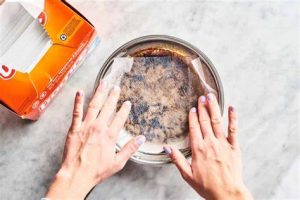
2. Soak the Sheet Pans
Fill your sink or a large container with hot water. Add a generous amount of dish soap and baking soda to create a degreasing solution. Submerge the preheated sheet pans in the solution, ensuring they are fully covered. Let them soak for 15-30 minutes to loosen the grease.
3. Scrub Gently
After soaking, use a sponge or scrub brush to gently scrub the sheet pans. The combination of dish soap, baking soda, and hot water will help to remove most of the grease and residue. Pay extra attention to areas with stubborn buildup.
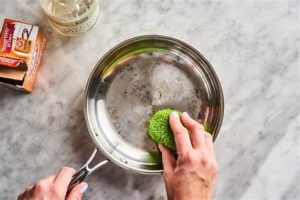
4. Use Aluminum Foil
For any particularly stubborn areas, crumple a piece of aluminum foil into a ball and use it to scrub the sheet pans. The abrasive texture of the foil can help dislodge even the toughest residues. Be gentle to avoid scratching the pan.
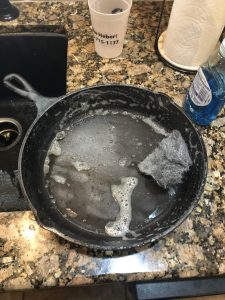
5. Rinse and Inspect
After scrubbing, rinse the sheet pans thoroughly with hot water to remove all traces of soap and residues. Inspect them to ensure that all grease and grime have been removed. If not, repeat the scrubbing process.
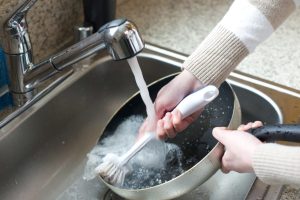
6. Vinegar Solution
For any lingering odors or a final touch, you can create a vinegar solution by mixing equal parts water and white vinegar. Soak the sheet pans in this solution for a few minutes and then rinse them thoroughly.

7. Dry Completely
Make sure the sheet pans are completely dry before storing them. Any moisture left behind can lead to rust, which can damage your pans.
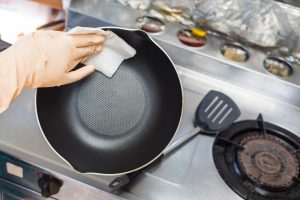
Preventing Future Grease Buildup
To keep your sheet pans in great condition and minimize future grease buildup, consider these preventative measures:
- Line with Parchment Paper: When baking, use parchment paper to line your sheet pans. This prevents direct contact between food and the pan, making cleanup a breeze.
- Use Cooking Spray: Apply a light coating of non-stick cooking spray before cooking to reduce sticking and make cleaning easier.
- Hand Wash: While sheet pans are often dishwasher-safe, hand washing is gentler on the pans and can help preserve their condition.
- Regular Cleaning: Make it a habit to clean your sheet pans promptly after use. Fresh stains and residues are easier to remove.
- Avoid High Heat: Limit the use of high-heat settings when cooking, as they can lead to stubborn stains and burnt-on residues.
https://th.bing.com/th/id/OIP.ujqquJnOLQH86qwunUTWMgHaE8?pid=ImgDet&w=474&h=316&rs=1
In Conclusion
The art of degreasing sheet pans is a simple but important skill for any home cook. By following these steps and maintaining good kitchen practices, you can keep your sheet pans in excellent condition, ensure hygienic cooking, and enjoy perfect results in your culinary endeavors. A clean and well-maintained sheet pan is an invaluable tool in the kitchen, and with these tips and tricks, it’s easy to achieve.







